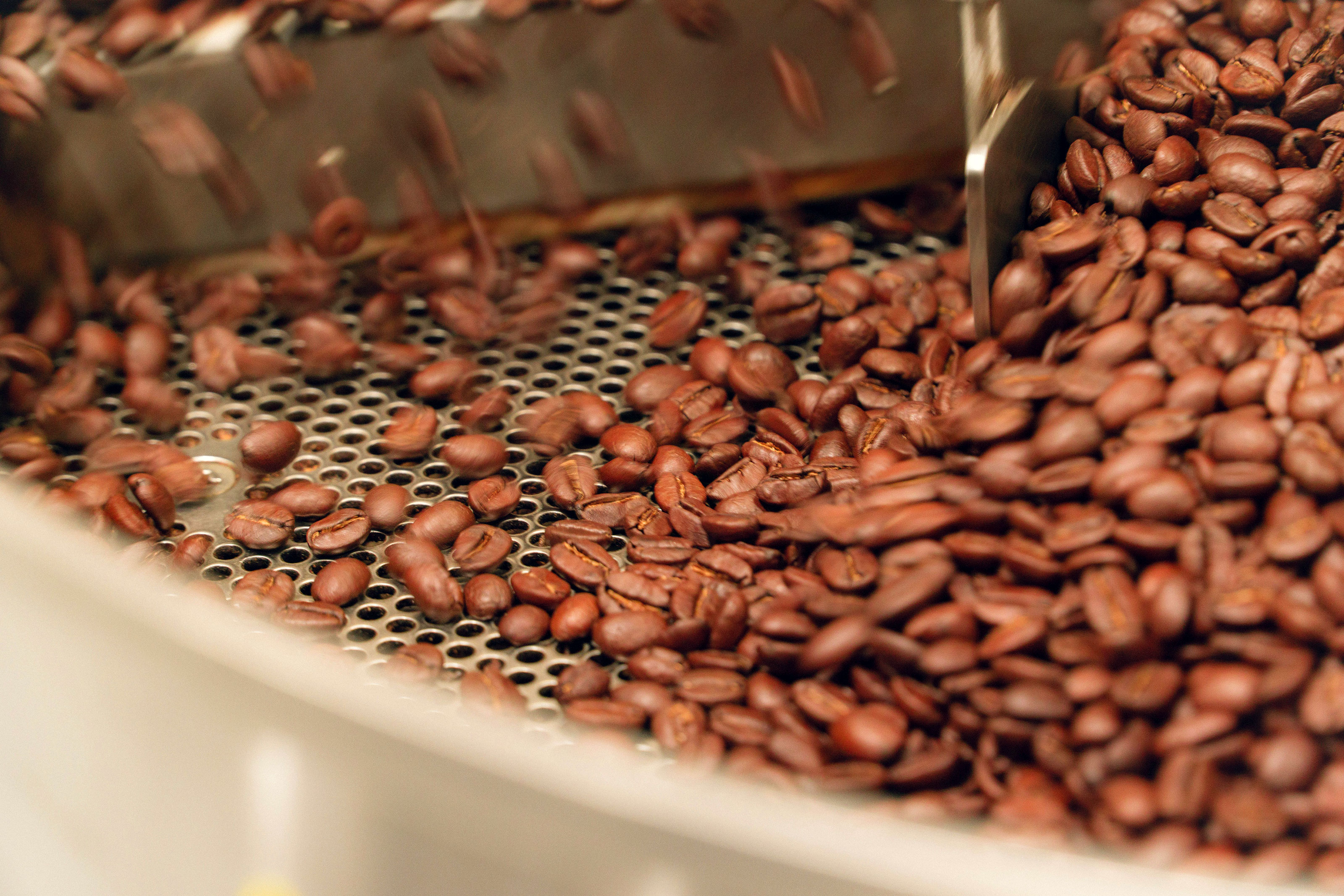Roasted to Perfection: A Fresh Guide to Home Coffee Roasting Machines
If you thought your morning coffee couldn’t get any better—wait until you roast your own beans.
Home coffee roasting might sound like a job for mad scientists or mustachioed baristas with too much time on their hands. But in truth, it’s one of the most satisfying ways to connect with your coffee, understand flavor, and elevate your brew game from “decent” to dang, that’s delicious.
Whether you're a total newbie or a full-blown caffeine chemist, this guide will walk you through the why, how, and what of home coffee roasting machines.
Why Roast Coffee at Home?
(Besides the fact that it makes your kitchen smell like a cozy artisan café)
If you’re wondering whether home coffee roasting is worth the effort, allow us to make a compelling (and delicious) case. Sure, you could just buy a bag of pre-roasted beans from your local shop or favorite online roaster—but once you try roasting your own, there’s no going back. Here’s why:
1. Freshness You Can Taste
Coffee beans don’t age like fine wine. Once roasted, they start to lose their flavor and aroma within days—yes, days. By the time a store-bought bag hits your mug, it might already be past its peak.
Home roasting gives you total control over freshness. After a short degassing period—usually 2 to 5 days depending on the roast—you’ll experience the beans at their absolute peak, with bold, vibrant flavors that store-bought coffee just can’t match
Tip:
Degassing = Flavor Development
If you brew your coffee too soon (within the first 12–24 hours), it can taste flat, sour, or even a bit "off." That CO₂ interferes with proper extraction during brewing and masks the coffee’s true flavor.
Ideal Brew Window:
- Light Roasts: 3–7 days post-roast
- Medium Roasts: 2–5 days
- Dark Roasts: Often ready in 1–2 days, but can benefit from 2–4 days of rest
Of course, these are general guidelines—some people love experimenting with ultra-fresh brews to taste how the profile evolves day by day. (One more perk of roasting at home!)
2. Total Flavor Control
Light roast with fruity notes? Deep, dark espresso-style roast? Somewhere in between with nutty undertones? When you roast your own coffee, you’re the flavor boss.
- Adjust time and temperature
- Experiment with origin and bean type
- Tailor each roast to your brewing method (pour-over, espresso, French press)
It’s like being your own barista, roaster, and mad scientist—minus the lab coat (unless you're into that).
3. Save Money Over Time
Green coffee beans are significantly cheaper than roasted ones—often 30–50% less. And they have a much longer shelf life (up to a year or more).
Once you invest in a home roaster, you’ll spend less on beans while still enjoying high-quality, specialty-grade coffee. Bonus: you can buy in bulk, which means fewer coffee runs and more café vibes at home.
4. Learn, Tinker, and Experiment
Home roasting isn’t just a hobby—it’s a hands-on way to connect with your coffee. You’ll learn how:
- Roast profiles impact flavor
- Origin affects sweetness and acidity
- Bean size and moisture change roasting times
It turns your daily brew into an ongoing learning experience. For coffee lovers who like a bit of science with their sip, roasting is the ultimate deep dive.
5. It’s Surprisingly Fun (and a Little Addictive)
There's something satisfying about watching green beans whirl, darken, crack, and turn into something drinkable. The sound of first crack? Pure music. The smell? Heavenly. The feeling of sipping a cup you roasted yourself? Totally worth the effort.
Many home roasters say what starts as a weekend experiment quickly becomes a full-blown ritual.
A Note on the Flip Side
Of course, home roasting does require a few things:
- A roasting machine (or creative workaround)
- Good ventilation (there will be smoke)
- A little patience and trial-and-error
But if you’re game for a little hands-on magic, the rewards are endless.
Roast It, Love It, Sip It
Roasting coffee at home lets you create a custom cup from the ground up (pun fully intended). It’s fresher, more flavorful, and totally tailored to your taste buds. Whether you’re in it to save money, experiment with origin flavors, or just level up your morning cup—home roasting is the gateway to next-level coffee.
Types of Home Coffee Roasting Machines
Home coffee roasters come in a few different flavors (much like the coffee itself). Whether you’re looking for ease, control, or just a cool new kitchen hobby, there’s a roasting method that fits your vibe. Here’s a breakdown of the four main types of home coffee roasting machines—and what you need to know before firing one up.
1. Air Roasters (Fluid Bed Roasters)
Like a hot-air popcorn popper, but built for coffee perfection.
These roasters blast hot air through the beans, keeping them in constant motion and creating a quick, even roast. They're ideal for beginners who want an easy, relatively hands-off roasting experience.
Pros:
- Fast roasting times (typically 6–10 minutes)
- Easier to learn and operate
- Compact and often budget-friendly
- Great for light to medium roasts
- Cool to watch—the beans dance!
Cons:
- Smaller batch sizes (usually 3–5 oz)
- Can be noisy (whooshing air isn't subtle)
- Less control over roast development compared to drum roasters
Best for:
New home roasters, small households, people who want a plug-and-play experience.
2. Drum Roasters
Think of it as the slow roast BBQ of the coffee world.
Drum roasters tumble the beans inside a rotating drum while heating them with indirect heat—usually via electric coils or an external gas burner. They allow for slower, more controlled roasts and are great for those who want to get deep into roast profiling.
Pros:
- Even, consistent roasting
- Larger batch sizes (8 oz to 1 lb or more)
- Greater control over time, temperature, and development
- Ideal for dark roasts and espresso lovers
Cons:
- More expensive than air roasters
- Larger footprint—requires dedicated counter space
- Steeper learning curve
- Often requires more ventilation (and sometimes an outdoor setup)
Best for:
Serious hobbyists, flavor perfectionists, and those ready to dive deep into the craft.
3. Stovetop Roasters (Manual Roasters)
Old-school roasting with modern-day satisfaction.
These are pan-style roasters or manual drum roasters that sit directly over your stove or gas burner. You control everything: heat, time, and movement. It’s the most hands-on—and sometimes most rewarding—way to roast.
Pros:
- Affordable and low-tech
- Durable, often stainless steel or cast iron
- Gives you a strong feel for the roasting process
- No electricity needed—great for off-grid setups
Cons:
- Manual agitation required (get ready to shake or crank!)
- No built-in temperature control
- Steeper learning curve, especially for consistency
- Can get smoky fast—ventilation is a must
Best for:
DIY lovers, campers, traditionalists, and coffee geeks who want total control.
4. Modified Popcorn Poppers
Yes, we’re serious. That old popcorn maker might be your entry into coffee roasting.
Before affordable home roasters became a thing, coffee lovers got creative—hijacking hot-air popcorn poppers to roast beans. And honestly? It still works.
Pros:
- Super budget-friendly
- Great for small batches and quick experiments
- Easy to find at thrift stores or online
- Fun, retro roasting experience
Cons:
- Not designed for coffee—can overheat or wear out
- No roast control features (you’ll need to time and watch closely)
- Requires modifications for serious use
- Small capacity (2–3 oz tops)
Best for:
Absolute beginners, DIY experimenters, and the coffee curious who want to try roasting without committing to expensive gear.
Summary Table: Roast Your Way
| Roaster Type | Best For | Batch Size | Learning Curve | Control Level | Price Range |
| Air Roaster | Beginners, light roast fans | Small (3–5 oz) | Low | Medium | $100–$300 |
| Drum Roaster | Hobbyists, espresso lovers | Medium–Large | Medium–High | High | $300–$1000+ |
| Stovetop Roaster | DIYers, off-grid roasting | Medium | High | High | $50–$200 |
| Popcorn Popper | First-timers, experimenters | Tiny (2–3 oz) | Low–Medium | Low | <$50 |
Choose the Roaster That Matches Your Style
There’s no “one-size-fits-all” when it comes to home coffee roasting—some people love the instant gratification of air roasters, while others thrive on the fine-tuned control of drum machines. And hey, some folks just like to roast beans in a popcorn popper while wearing fuzzy slippers. No judgment.
Whatever your style, there’s a roaster out there ready to bring your coffee obsession to the next level.
What Makes a Great Home Roaster?
Shopping for a home coffee roaster can feel a bit like entering a new relationship: some are fun but flaky, others are complex and high-maintenance, and a rare few are the perfect long-term match.
So before you fall head over heels for the first shiny machine you see online, let’s talk about what actually makes a coffee roaster great — not just “good enough.”
1. Consistent, Even Roasting
No one likes a bean that’s half-burnt, half-raw. A great roaster should deliver an even roast from start to finish, without scorched spots or pale patches. Uniform heat distribution and steady agitation (bean movement) are key.
Look for:
- Rotating drums or high-speed fans
- Machines that prevent beans from “stalling” or sitting still too long
- Even color development after roasting
Pro tip: Consistency isn’t just about flavor — it also helps when dialing in your brews.
2. Control Over Time, Temp & Airflow
Every bean is different. Some need a slow build-up to first crack; others need a faster roast to highlight sweetness. A great roaster gives you the reins to guide the roast, not just press a button and hope.
Must-have controls include:
- Adjustable temperature
- Roast time / development control
- Fan or airflow settings (especially for air roasters)
- A way to cool beans quickly post-roast
The more control you have, the more you can customize your flavor profiles — fruity, chocolaty, nutty, smoky... you're the artist.
3. Easy to Clean (Because Old Chaff Is Gross)
Roasting coffee gets messy. There’s smoke, chaff (papery bean skins), oil, and lots of smell. If your machine is a pain to clean, you’ll dread using it—and trust us, that’s a fast path to giving up on home roasting altogether.
A great roaster should have:
- A removable chaff collector
- Easy access to the roasting chamber
- Straightforward maintenance (no tiny screwdrivers required)
4. Good Ventilation or Smoke Suppression
Here’s the not-so-fun part: coffee roasting creates smoke. Sometimes a lot of it. If your roaster doesn’t have proper ventilation or a smoke-reducing system, your kitchen may smell like a bonfire for days.
Look for:
- Built-in smoke suppression or exhaust fans
- Recommendations for outdoor use or near windows
- Clear guidelines for venting if you're using a drum roaster
Unless you're trying to start a coffee-scented fog machine business, make sure your machine handles the haze.
5. Fast Cooling Feature
After roasting, your beans need to cool quickly to stop the roast from continuing (known as "carryover"). The best machines come with a built-in cooling cycle—or at least allow you to cool beans manually in a flash.
Why does this matter? Because a perfect medium roast can accidentally become dark if it doesn’t cool fast enough. Think of it like overcooking pasta—you just can’t undo it.
6. Clear Interface or Visibility
Whether it’s a simple dial or a digital interface, the controls should feel intuitive—and if the machine lets you see the beans as they roast, even better.
Look for:
- Easy-to-read displays or knobs
- Clear visibility into the roasting chamber
- Audible cues like first crack (and even second)
Bonus: watching the beans go from green to golden brown is weirdly satisfying.
7. Reasonable Noise Level
All roasters make some noise—fans, motors, cracks—but too much noise can prevent you from hearing key roast stages like the first crack. And that matters when you're trying to pinpoint roast development.
Tip: If it sounds like a jet engine, it might not be ideal for indoor use.
8. Fits Your Space & Lifestyle
The perfect roaster is one you’ll actually use. If it’s too bulky for your counter, too fiddly to clean, or too loud for your 6 a.m. routine, it’ll end up in the cupboard next to the waffle iron.
Think about:
- Roast capacity (how much you need per week)
- Machine size and where you’ll store it
- How much time you want to spend per roast
The 3 C’s of a Great Home Roaster
- Control – over heat, time, airflow, and roast profiles
- Consistency – even roasting with repeatable results
- Convenience – easy to use, clean, and store
If a machine hits all three, you're not just buying a roaster—you're investing in better mornings, one batch at a time.
5 Standout Home Coffee Roasting Machines
1.JIAWANSHUN Coffee Roaster&Coffee Bean Cooler (from $145)
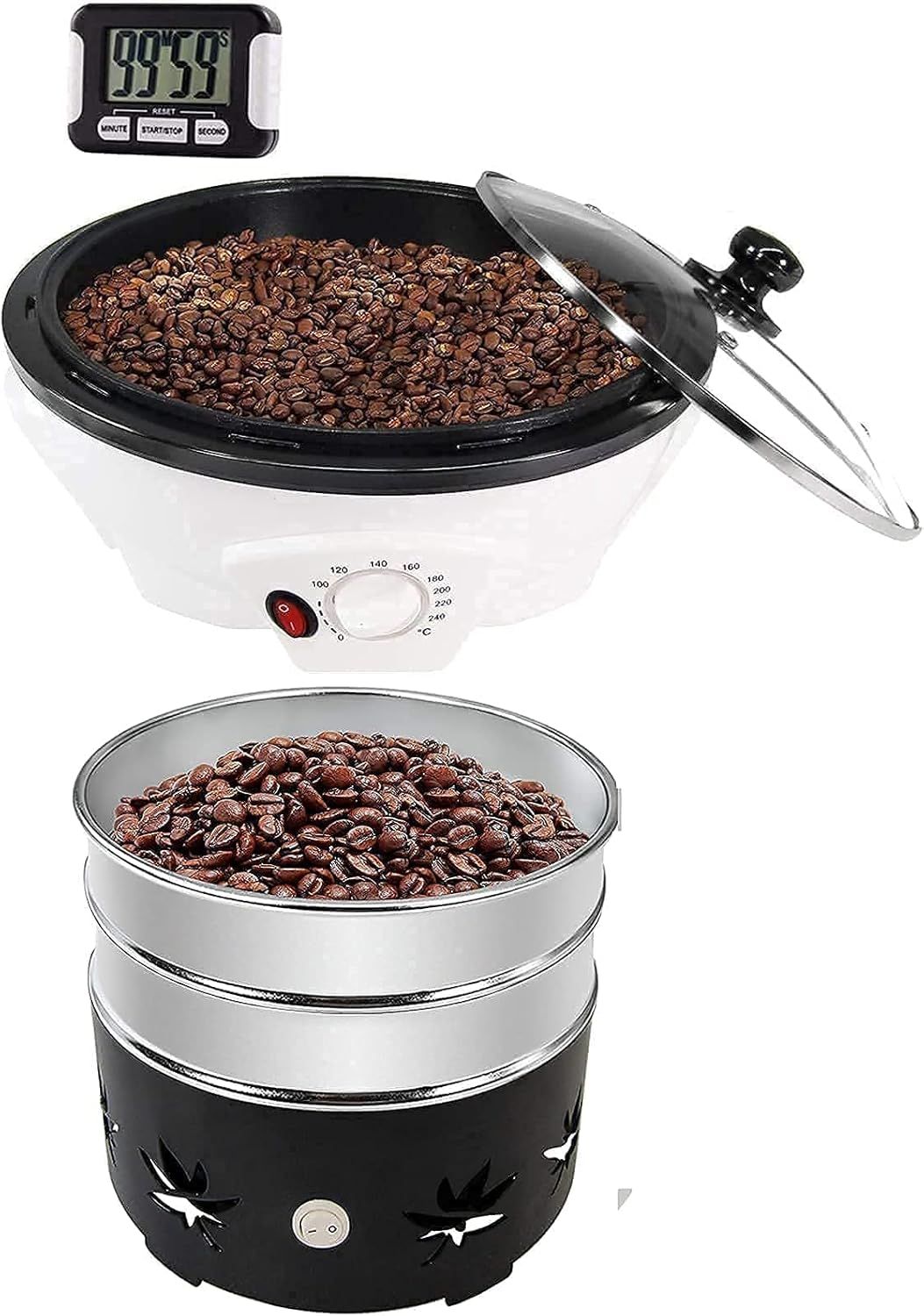
The JIAWANSHUN Upgraded Electric Coffee Bean Roaster is designed for those who wish to explore the art of home coffee roasting with precision and ease. This machine offers a blend of functionality and user-friendly features, making it suitable for both beginners and seasoned coffee aficionados.
Key Features
- Adjustable Temperature Control (100–240°C): Allows for precise roasting, accommodating various bean types and desired roast levels.
- Timer Function: Enables users to set roasting durations, ensuring consistency and preventing over-roasting.
- Large Capacity (Up to 800g): Suitable for small to medium batches, ideal for personal use or small gatherings.
- Automatic Mixing Rod: Ensures even roasting by continuously agitating the beans during the process.
- Versatility: Capable of roasting not only coffee beans but also nuts, peanuts, melon seeds, and popcorn, adding to its multifunctionality.
Design & Build
The roaster features a durable construction with a transparent lid, allowing users to monitor the roasting process. Its compact design ensures it doesn't occupy much counter space, making it suitable for most kitchen setups.
User Experience
Users have reported that the JIAWANSHUN roaster is straightforward to operate, with intuitive controls. The adjustable temperature and timer functions provide flexibility, while the automatic mixing rod ensures uniform roasting. However, it's recommended to avoid roasting less than 300g of beans, as this may lead to uneven roasting.
Maintenance & Cleaning
The roaster's design facilitates easy cleaning. The removable components can be washed, and the non-stick surface reduces the buildup of residues, ensuring longevity and consistent performance.
Pros & Cons
Pros:
- Affordable price point for those new to home roasting.
- Adjustable temperature and timer for customizable roasting.
- Large capacity suitable for personal use.
- Versatile functionality beyond coffee beans.
Cons:
- Roasting less than 300g may result in uneven roasting.
- May require monitoring during the roasting process to achieve desired results.
2. NIASIA 500 g Automatic Coffee Roaster Machine (from $500)
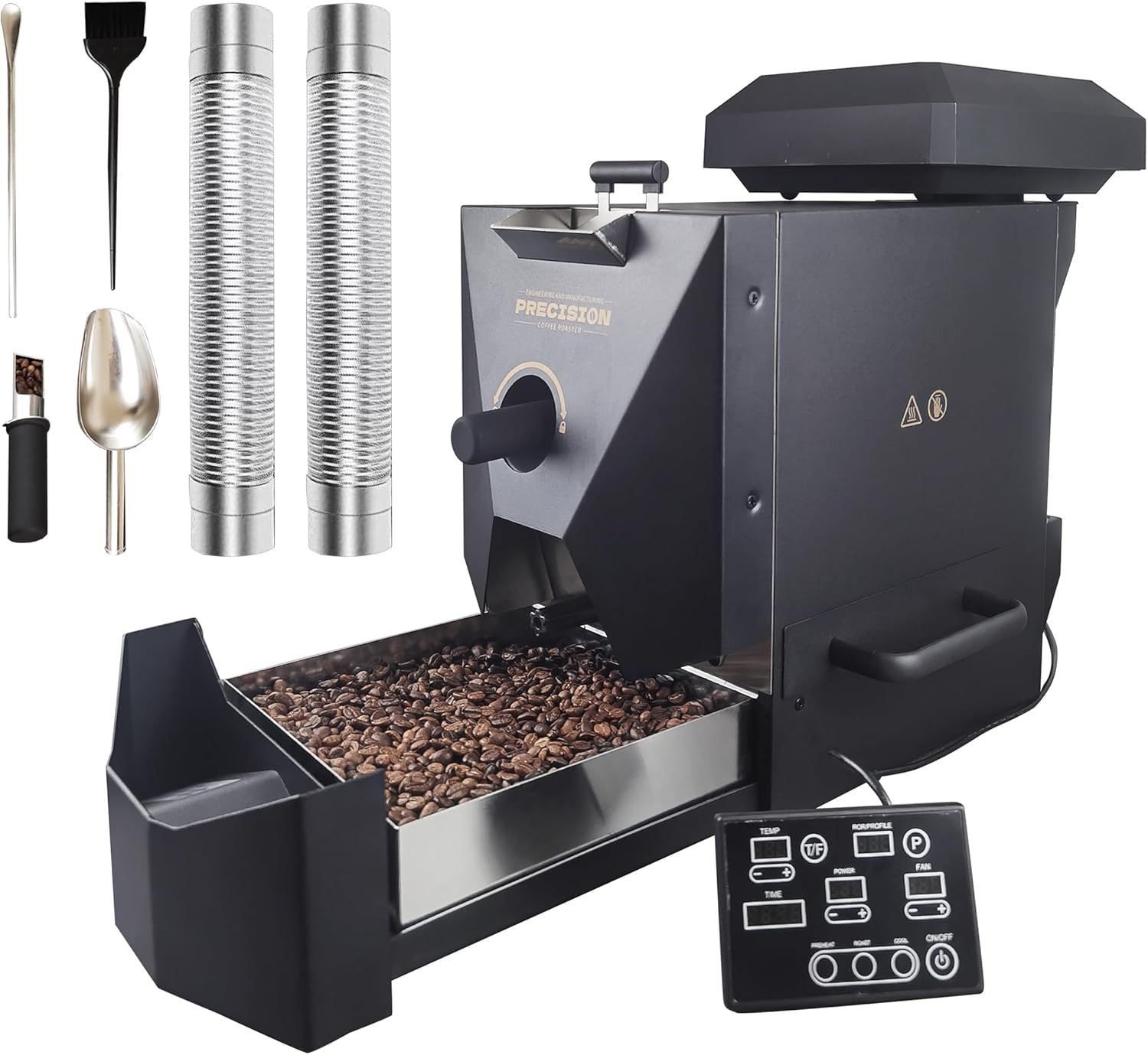
What Sets It Apart
This model strikes a smart balance between automation and hands-on flexibility—perfect for both newbies and seasoned home roasters alike:
- Dual Modes: Automatic (with 9 built-in roast profiles) or Manual Mode—great for dialing in special beans like sun‑dried, washed, or honey‑processed.
- Generous Capacity: Up to 500 g per roast, though best results come with 350–400 g batches.
- Smoke Management: A built-in smoke filter helps for lighter roasts; for darker roasts that naturally produce more smoke, it includes two aluminum alloy exhaust pipes to vent outdoors.
- Rapid Cooling System: Equipped with a high-speed fan and removable cooling tray to quickly bring post-roast beans to temperature—helping lock in flavor.
- Accurate Temperature Control: Features a precise probe and intelligent controller, so your beans never stray from their ideal roast curve.
Pros & Cons
| Pros | Cons |
| Huge capacity for home use (up to 500 g) | Large footprint—requires dedicated countertop space |
| Automatic profiles for ease, manual mode for experimentation | Pricier than compact countertop models |
| Built cleanup tools (chaff collector, smoke filter) | Some users report durability concerns—occasional early failure reported |
| Strong smoke control features | Drum cleaning requires partial disassembly—not instant cleanup |
Who It's For (and Who Might Look Elsewhere)
This roaster is ideal for:
- Home roasting enthusiasts who want bulk roasting with consistency
- Users looking for automatic ease for batch roasting
- Buyers with enough counter space, and who value smoke mitigation
Maybe not the best fit if you:
- Need a compact roaster or are short on kitchen space
- Are on a tight budget
- Want ultra-simple, low-maintenance cleanup
- Prefer a noise-free, smoke-free setup (even with the filter)
The NIASIA 500 g automatic coffee roaster is a high-capacity, feature-packed tool that brings semi-pro roasting into your home—if you’re ready to commit space and budget. It’s built for crafting consistent, flavorful batches, with thoughtful smoke and cleanup systems to keep the process contained and kitchen-friendly.
3. Kaldi Wide Home Roaster (from $620)

At a Glance
The KALDI WIDE is a motorized, gas-powered drum roaster built to mirror the control and feel of commercial roast rigs—just downsized for your countertop. With thoughtful design details and robust materials, it’s made for folks who take home roasting seriously.
Key Features & What's Inside the Box
- 300 g Professional Drum System
- Flame Arrest Mesh Plate
- Integrated Accessory Kit
- Manual Motorized Drum Rotation
- Stainless Steel Build & Design
A thick 2 mm stainless steel drum with 3 mm perforations and three stirring blades ensures even bean agitation and heat penetration. Ideal-sized capacity for small-batch mastering.
This innovative mesh transforms your gas flame into a clean, square blaze—maximizing heat efficiency and stability. It’s a pro move in compact form.
Comes loaded: a user-friendly hopper assembly (includes analog thermometer), bean sampler, and a chaff tray built into the hopper. Once roasting is done, just remove the hopper, tilt, and beans slide out into the cooling tray.
Driven by a quiet motor (~30 RPM), this ensures smooth, consistent roasting without requiring manual shaking.
Nearly 6 kg of polished durability in a compact 46 × 17 × 37 cm frame—built to impress and built to last.
Pros:
- Very robust, almost commercial-grade build quality. Reviews call its design “solid,” “reliable,” and “beautiful.”
- Consistent roasts when paired with good burner control—users note better flavor than electric drum roasters like Behmor.
- Easy bean discharge and integrated chaff handling make cleanup simpler than many drum roasters.
- Compact footprint yet sizable capacity—great for home use and enough for daily or weekend roasting sessions.
Cons:
- High ventilation needs—you’ll need heavy-duty kitchen airflow or outdoor setup to manage smoke and chaff.
- Intensely manual in control, with no digital temp control or logging; some roasters add temperature probes and flame valves to dial it in (e.g., Artisan + thermocouples).
- Tricker to use in small batches—some users report uneven results when roasting under ~200 g.
Who Should Consider the KALDI WIDE?
Great choice if you:
- Roast frequently and value consistent control
- Want semi-pro roasting feel without the commercial price tag
- Have space for a gas burner and ventilation
- Love hands-on craft and don’t mind manual nuance
Maybe steer clear if you:
- Prefer plug-and-play electric simplicity
- Need ultra-quiet, indoor-friendly operation
- Don’t have stable airflow or outdoor space for smoke
The KALDI WIDE is not just a roaster—it’s a bridge between hobby and craft. It gives you tangible control, robust design, and a commercial-level feel in your garage or kitchen. If you're ready to step up from beginner roasts and venture into serious flavor exploration, this is a stellar machine.
4. Fresh Roast SR800 (from $334)
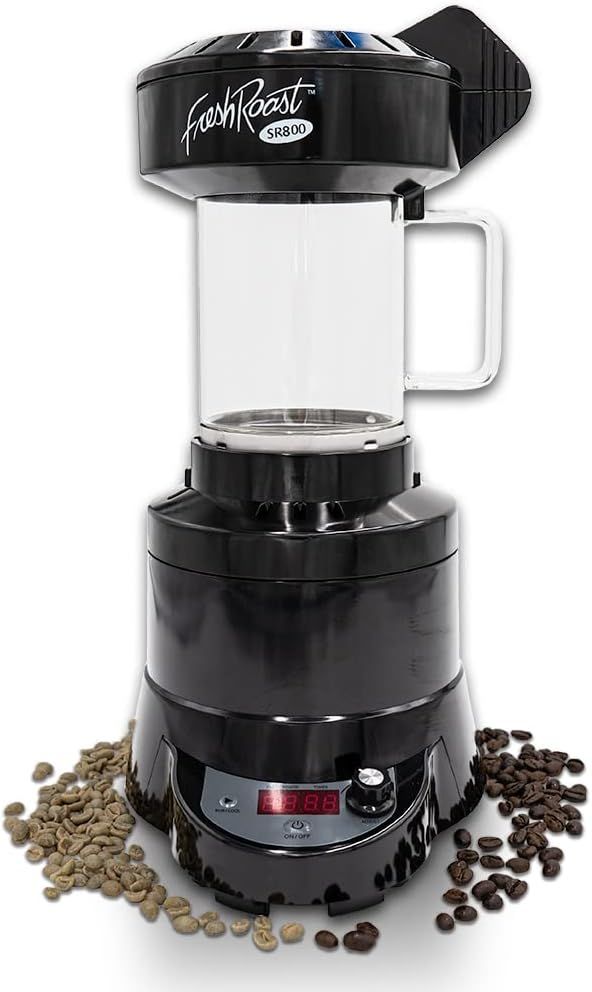
What Makes It Stand Out
1. Generous 8 oz (≈226 g) Capacity
Perfect for roasting half a pound of beans—plenty for a week of fresh cups. For dry-processed beans (which shed more chaff), reducing to about 6 oz is recommended.
2.Intuitive Push-Turn Knob Controls
A single knob elegantly handles heat, fan speed, and timer adjustments. Nine heat levels and a broad fan range give you much more granularity than older models' just Low/Med/High settings.
3.Real-Time Temperature Monitoring
Spin the knob to the right and instantly see your roast temperature—no thermocouple needed.
4.Compact, Transparent Design
With a slender footprint (~8.5″ wide x 14″ tall), the SR800 fits most kitchen spaces. The glass roasting chamber provides a live, satisfying view of beans transitioning from green to golden brown.
5.Superior Chaff Collection & Integrated Cooling Cycle
A chaff collector helps keep the workspace tidy, and hitting the “Cool” mode helps halt roast progression immediately when needed.
What Users and Experts Say
“This machine is easy to use, fun, and gives you ample control without drowning in complexity." It roasts fast (under 20 minutes) and handles more volume than the smaller SR540.
“Easy to use—perfect for beginners. You just control fan, heat, and time.” Also, a single roast (about 8 oz) makes plenty of coffee for a week, and it's quieter than popper-based models.
“Balancing heat and airflow together is a bit tricky”—users note a learning curve in mastering fan vs. heat settings.
Others recommend using the extension tube, which improves chaff handling and airflow.
Noise or smoke complaints arise if ventilation is inadequate (e.g., roast with a fan or outside when doing darker profiles).
Quick Pros & Cons Table
| Pros | Cons |
| Easy to use and beginner-friendly | Produces noticeable smoke—needs ventilation |
| Precise control via knob over heat, fan, time | Some parts (lid, chaff basket) feel fragile |
| Great visibility during roast process | Fan/heater may wear over time—spares available |
| Fires up full batches quickly with good chaff control | Learning curve in balancing settings |
If you're looking for a home roaster that hands off control without complicated menus or fragile glass components, the Fresh Roast SR800 hits a sweet spot. It's capable, tidy, and familiar enough for beginners—all while letting serious enthusiasts fine-tune their brew. Just make sure you've prepped your space for airflow and have a few cooling hacks at the ready!
5. Nuvo Eco Ceramic Handy Coffee Bean Roaster (from $31)
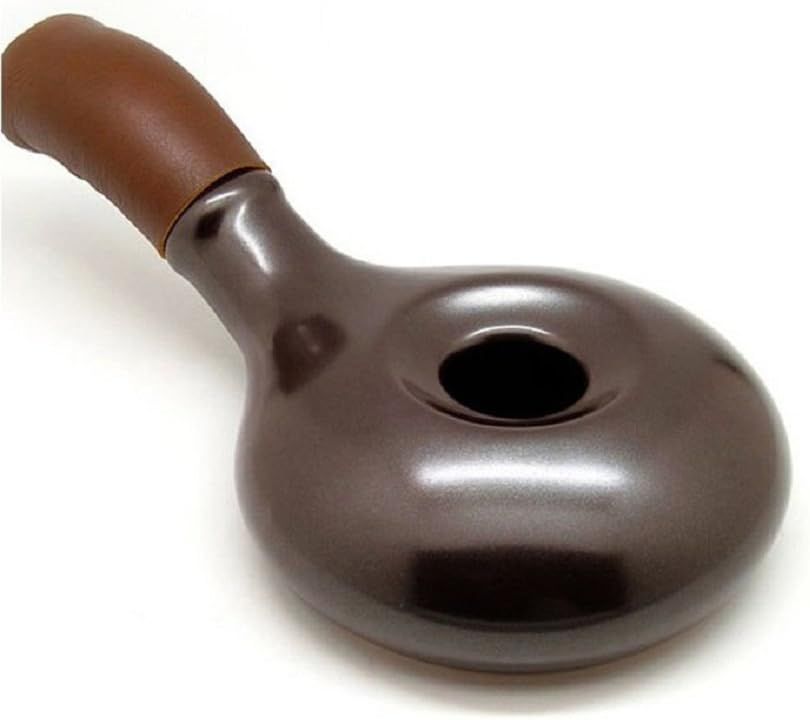
What Makes It Special?
1.Ceramic Craftmanship
This handheld roaster is crafted from heat-fired ceramic, with a waffle-textured interior for more even roasts and improved thermal transfer. The cowhide-wrapped handle keeps things safe and classically stylish.
2.Perfect for Micro-Batches
Designed for small-batch roasting, it handles approximately 30–70 grams—just enough for 2–3 adult espresso shots. A cozy, hands-on experience rather than industrial-scale efficiency.
3.Portable and Eco-Conscious
At its core, this is a back-to-basics roaster: great for camping, kitchens, or anywhere you want fresh-roasted magic without bulk. Its “eco” moniker refers to its recyclable ceramic build and lack of plastic parts.
4.Manual Roasting Ritual
You roast by hand—heating over a flame or hotplate, then continually swirling and shaking to avoid scorching. You'll hear the beloved “pop” of first crack echo through the small back vent, keeping you attuned to roast progress.
The Pros & Cons at a Glance
| Pros | Cons |
| Charming ceramic design with heat-retaining waffle interior | Tiny capacity means slow, multiple batches |
| Love the direct, tactile roasting feel? This is pure analog joy | Manual shaking gets tiring over extended roasts |
| Portable and easy to take outdoors or camping | Produces lots of smoke—ventilation is a must |
| Builds patience and appreciation for roast-by-hand | Some users find uneven results and long roast times |
Who Should Give It a Go?
This roaster is ideal for you if you:
- Love tactile, hands-on roasting experiences
- Want minimalist, visually pleasing tools in your kitchen
- Roast small batches and don’t mind investing time in each one
- Could use a thoughtful morning ritual and don’t mind the occasional arm workout
Maybe look elsewhere if you:
- Need higher capacity or faster turnover
- Prefer low-fuss, plug-and-play roasting
- Roast daily for large groups or families
- Are looking for digital precision or auto-stop control
The Nuvo Eco Ceramic Handy Roaster isn’t just a tool—it’s a conversation about craft, control, and tradition. It invites you to slow down, listen for the cracks, and taste coffee on your own terms.
Tips for Roasting Like a Pro (Even If You’re Not One)
- Start with small batches – You’ll make mistakes. That’s part of the fun.
- Keep notes – Track roast time, temperature, and bean type.
- Ventilate well – Roasting coffee gets smoky. Open windows, turn on fans.
- Let beans rest – After roasting, let beans degas for 24–72 hours before brewing.
- Experiment – Change one variable at a time (time, heat, or bean variety) and taste the difference.
Moka Pot? French Press? Dial It In.
The beauty of home roasting is that it unlocks flavor potential across every brew method. Want brighter notes in your pour-over? Roast lighter. Crave syrupy depth for your French press? Go darker. With a home roaster, you're not just drinking coffee—you’re designing it.
Is Home Roasting for You?
If you love coffee and don’t mind a little trial and error, absolutely. Home roasting gives you total control over flavor and freshness, and there’s something deeply satisfying about sipping a cup made entirely by your hands—from green bean to golden crema.
Whether you’re starting with an air roaster like the Fresh Roast SR540 or diving deep with a Kaldi drum roaster, there’s a machine out there ready to fire up your next obsession.
